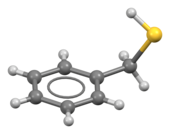Benzyl mercaptan
It is a common laboratory alkylthiol that occurs in trace amounts naturally.
The initially formed isothiouronium salt must be subjected to alkaline hydrolysis to obtain the thiol.
It has been identified in boxwood (Buxus sempervirens L.) and is known to contribute to the smoky aroma of certain wines.
Debenzylation can be effected by dissolving metal reduction:[4] Condensed tannins undergo acid-catalyzed cleavage in the presence of benzyl mercaptan.
Methoxy-substituted benzyl mercaptans have been developed that cleave easily, are recyclable, and are odorless.


